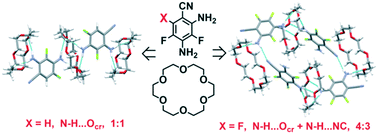The article with participation of NIOCh's researcher is published in CrystEngComm, (IF 3,545)
Co-crystals of polyhalogenated diaminobenzonitriles with 18-crown-6: effect of fluorine on the stoichiometry and supramolecular structure
Tamara A. Vaganova, Yurij V. Gatilov, Sergey E. Malykhin, DenisP. Pishchur, Maxim Sukhov, Boris A. Zakharov, Elena V. Boldyreva and Evgenij V. MalykhinCrystEngComm, 2021, V. 23, N 7, Pp 4767-4781
https://doi.org/10.1039/D1CE00530H

Abstract
A series of polyhalogenated diaminobenzonitriles and 18-crown-6 ether were used to reveal the dependence of the stoichiometry and supramolecular structure of co-crystals on various factors. 2,6-Diamino-3,5-difluoro-, 2,6-diamino-4-chloro-3,5-difluoro-, and 2,6-diamino-4-chloro-3-fluorobenzonitriles, as well as 2,4-diamino-3,5-difluorobenzonitrile give 1 : 1 co-crystals regardless of the diamine : crown ratio in the crystallization solution (from 2.5 : 1 to 1 : 2.5) and the nature of the solvent. According to X-ray diffraction data, the supramolecular structures of these co-crystals can be considered as 1D assemblies with the only structure-forming N–H⋯Ocr hydrogen bond. 2,4-Diamino-3,5,6-triflurobenzonitrile forms no 1 : 1 co-crystal, but yields co-crystals of 4 : 3 (under most of the studied conditions) and 2 : 1 (in CCl4 solution) stoichiometry. The N–H⋯NC hydrogen bond and p⋯π electron interactions, along with the N–H⋯Ocr H-bond, participate in the formation of the 3D supramolecular structures of these co-crystals. The effect of the number of F atoms on the co-crystallization behaviour of difluoro- and trifluoro-2,4-diaminobenzonitriles was rationalized using quantum-chemical computations of the interaction energies of N–H⋯NC bonded pairs of these diamines in the experimental crystals and DFT simulated models. The DSC curves of each co-crystal contain a single peak corresponding to a crystal-to-liquid phase transition (melting), which does not change in melting–crystallization cycles, indicating that the stoichiometry and crystal structure are reproducible.
- This article is part of the themed collections: Supramolecular & Polymorphism and CrystEngComm HOT articles
Альметрики:


